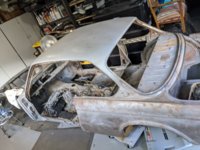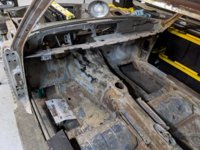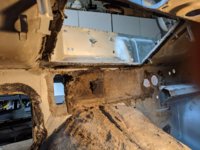You are using an out of date browser. It may not display this or other websites correctly.
You should upgrade or use an alternative browser.
You should upgrade or use an alternative browser.
Prior to Acid Bath Part Removal Question
- Thread starter SkiFast
- Start date
I did nothing with these brackets in my car before dipping. They are spot welded in place.
A magnet can be your friend regarding AL or Steel (except for stainless steel).
Thanks all! I think I'm ready to road trip this car to Oregon for a bath. Removed all things removable, aluminum, adhered to or bolted. I plan to take the hinges and other painted parts (if its an option). Anything else to consider?
Maybe post some pre-shipping pictures so we can look it over... chances are someone will find something 
Do drop them as many parts you want to freshen up. But likely they will just add it all to the bill.
Dipping is especially effective in getting rust out of surfaces and ready for filler/paint. The heater motor cover on the engine side is an ideal candidate, as are the two headlight inspection plates.
Seams are notoriously difficult, capilar action draws only get a small amount of acid, which is often not enough to eat the rust, but it is enough weep the acid later on giving you back what you wanted to get rid off. Good shops flush (high pressure) well enough to prevent that from happening.
Did you remove all of the slip-on type on sheet nuts? Fuel door? Rubber floor plugs (8 of them I think) the white plastic plugs covering the wax injection holes (2 in each rear wheel arch, 3 or so on the inside of each rocker and 1 on each corner of the rocker, under the car near the subframe mount?
Secondly, it helps to think about how the car will be dipped and where air pockets may occur. Some times a well placed small drilled hole will ensure clean surfaces all around.
It applies to e-coat (zinc) layers even more so.
Dipping is especially effective in getting rust out of surfaces and ready for filler/paint. The heater motor cover on the engine side is an ideal candidate, as are the two headlight inspection plates.
Seams are notoriously difficult, capilar action draws only get a small amount of acid, which is often not enough to eat the rust, but it is enough weep the acid later on giving you back what you wanted to get rid off. Good shops flush (high pressure) well enough to prevent that from happening.
Did you remove all of the slip-on type on sheet nuts? Fuel door? Rubber floor plugs (8 of them I think) the white plastic plugs covering the wax injection holes (2 in each rear wheel arch, 3 or so on the inside of each rocker and 1 on each corner of the rocker, under the car near the subframe mount?
Secondly, it helps to think about how the car will be dipped and where air pockets may occur. Some times a well placed small drilled hole will ensure clean surfaces all around.
It applies to e-coat (zinc) layers even more so.
Last edited:
Great checklist Erik, I'll double check.Do drop them as many parts you want to freshen up. But likely they will just add it all to the bill.
Dipping is especially effective in getting rust out of surfaces and ready for filler/paint. The heater motor cover on the engine side is an ideal candidate, as are the two headlight inspection plates.
Seams are notoriously difficult, capilar action draws only get a small amount of acid, which is often not enough to eat the rust, but it is enough weep the acid later on giving you back what you wanted to get rid off. Good shops flush (high pressure) well enough to prevent that from happening.
Did you remove all of the slip-on type on sheet nuts? Fuel door? Rubber floor plugs (8 of them I think) the white plastic plugs covering the wax injection holes (2 in each rear wheel arch, 3 or so on the inside of each rocker and 1 on each corner of the rocker, under the car near the subframe mount?
Secondly, it helps to think about how the car will be dipped and where air pockets may occur. Some times a well placed small drilled hole will ensure clean surfaces all around.
It applies to e-coat (zinc) layers even more so.
A bit of a unicorn here. The car was in a trailer, unopened for nearly 16 years.
Inside was new fenders (inner & outer), rocker panels (inner & outer), right side quarter panel, hood, trunk, and a few more items.
Pretty easy to see most everything, though paid the dumb tax on a few items in the removal process (visor clips, a few screws, etc.).





